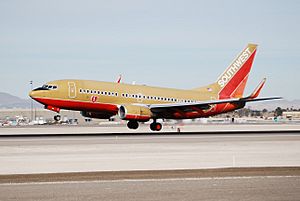History of Southwest Airlines facts for kids
Southwest Airlines started in 1966 when Herbert Kelleher and Rollin King had an idea. They wanted to create an airline that would fly only within Texas, connecting cities like Dallas, Houston, and San Antonio. By staying within Texas, they hoped to avoid strict federal rules, which would let them offer lower prices than other airlines.
However, three other airlines tried to stop them with lawsuits. These legal battles lasted until 1970. In 1971, the company officially became Southwest Airlines. By 1975, Southwest began flying to more cities in Texas. After a new law in 1978 that made it easier for airlines to fly anywhere, Southwest started flying to nearby states in 1979. They expanded to the East and Southeast in the 1990s and to Denver in 2006, which is now one of their busiest spots. Southwest Airlines was very successful, making a profit for 47 years in a row, from 1973 to 2019.
In the 2020s, Southwest faced some big challenges. During the 2022 holiday season, they had a major problem, canceling over 15,000 flights. This was due to bad weather and old computer systems. The U.S. government fined them a record $140 million, and the airline lost a lot of money.
A large investment group called Elliott Investment Management bought a big part of Southwest's shares. They wanted the airline to make changes to improve its business. In October 2024, Southwest and Elliott reached an agreement. The former CEO, Gary Kelly, stepped down from his leadership role, and five new directors supported by Elliott joined the board. The current CEO, Bob Jordan, remained in his position.
Under this new leadership, Southwest started making big changes. They had their first-ever layoffs, affecting about 15% of employees. They also ended their popular policy of two free checked bags on May 28, 2025. Starting in 2026, they will switch to assigned seating instead of open seating. They are also adding new options like premium seats, basic fare tickets, and red-eye flights (overnight flights). Flight credits now expire after one year. Southwest also started listing its flights on other travel websites like Expedia and Google Flights and began a partnership with Icelandair.
How Southwest Airlines Started
Early Ideas and Challenges
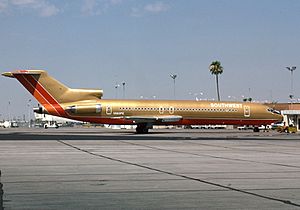
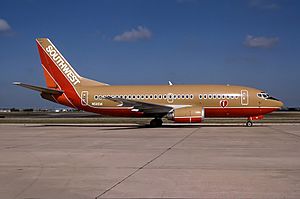
Southwest Airlines began on March 15, 1967, as "Air Southwest Co." in San Antonio. Rollin King had the idea, and Herb Kelleher was his lawyer. They wanted to create an airline that flew only within Texas.
By flying only within one state, these airlines could avoid many strict federal rules. This gave them more freedom to choose routes, set prices, and decide how often to fly. A successful airline in California, Pacific Southwest Airlines (PSA), inspired Southwest's business model.
Southwest applied for a special certificate from the Texas Aeronautics Commission (TAC) in November 1967. They received approval in February 1968. But three other airlines immediately sued to stop Southwest. This started a legal battle that lasted over two years. In May 1970, the Texas Supreme Court finally sided with Southwest. The U.S. Supreme Court later refused to hear the case. These lawsuits cost Southwest $530,000, leaving the company short on cash.
Getting Flights Off the Ground
Lamar Muse became the president and CEO in January 1971. He was an experienced airline executive. Muse quickly changed the airline's name to Southwest Airlines and moved its main office to Dallas. He also raised $1.25 million to help the company recover from its legal costs.
Southwest was able to start flights by June 18, 1971. They bought three 737-200 planes at good prices. They also hired pilots from another airline that had recently closed. Southwest even copied operating manuals from PSA to help get approval from the Federal Aviation Administration (FAA). Another California airline, Air California, helped train Southwest's flight attendants.
To get more money, Southwest offered shares to the public in early June. Many people from California who knew about PSA bought shares. Southwest openly admired PSA, with Muse saying, "We don't mind being copycats." Southwest also focused on having friendly flight attendants. They even advertised by writing an open letter to actress Raquel Welch, asking for applications from women like her. About 1200 women applied.
Southwest's first scheduled flights began on June 18, 1971. They flew between Dallas Love Field and Houston Intercontinental Airport, and between Dallas and San Antonio.
Even after Southwest got its certificate, other airlines kept trying to stop it. They argued that Southwest should be regulated by the federal government. But the courts disagreed, saying the lawsuits were becoming "harassment." Some competitors even faced charges for trying to block Southwest's service.
Becoming Profitable
Southwest lost money at first. They focused on business travelers, but their lower fares didn't attract enough customers. In October 1971, they bought a fourth 737 plane to offer hourly flights between Dallas and Houston, which added to their costs.
Several things helped them turn things around:
- Low-cost flights: Southwest started selling cheap tickets for flights during off-peak times, like Friday evenings and weekends. These "Pleasure" fares became very popular, bringing in more customers and helping the airline use its planes more often.
- Selling a plane: In May 1972, Southwest sold its fourth 737 plane. To keep offering hourly service with only three planes, they had to turn planes around at airports in just 10 minutes. This "10-minute turnaround" became a key part of Southwest's success, helping them save a lot of money.
- Moving to Hobby Airport: All Houston flights had moved to Houston Intercontinental in 1969. But Hobby Airport was closer to downtown Houston. Southwest reopened the Hobby terminal, which was more convenient for many passengers. This move gave Southwest a lasting advantage over its competitors.
Southwest lost $3.8 million in 1971 and $1.6 million in 1972. But in 1973, they made a profit of $175,000. They carried more passengers and earned more money per trip. By the end of 1973, Southwest ordered another plane. Southwest didn't have another annual loss until the COVID-19 pandemic in 2020.
Staying at Love Field
Dallas/Fort Worth Regional Airport (DFW) opened in January 1974. Before DFW opened, all airlines at Dallas Love Field agreed to move to DFW. The cities of Dallas and Fort Worth also agreed not to allow commercial flights at any other airport once DFW opened.
However, Southwest didn't exist when these agreements were made, so they weren't part of them. Also, Southwest was regulated by the Texas commission, not the federal board that pushed for DFW. Since Love Field received federal money, it couldn't stop airlines from using it. In late 1971, Southwest said it would stay at Love Field because it was more convenient. The cities of Dallas and Fort Worth sued them. This started a five-year legal battle, which Southwest won in 1973. A federal court in 1977 said, "This is the eighth time in three years that a federal court has refused to support the eviction of Southwest Airlines from Love Field."
Growing in Texas
In 1973, Southwest wanted to add a new city: Harlingen in the Rio Grande Valley of Texas. They believed this area was not well served by airlines. In late 1974, the Texas commission approved this. Another airline, Texas International (TI), immediately challenged it in court.
However, in February 1975, TI's pilots went on strike. The Texas commission gave Southwest emergency approval to start flights to Harlingen right away. Southwest quickly set everything up and began service. Legal challenges continued until October 1976, but Southwest had already been flying the route for over a year and a half. In the same month, Southwest got approval for five more Texas cities: Austin, Corpus Christi, El Paso, Lubbock, and Midland/Odessa. By January 1977, Southwest was free to start flying to these new places.
Southwest was now not only profitable but also becoming very strong on its routes. By May 1976, Southwest had 73% of the market share on its four routes. They were growing the market and pushing out much larger airlines. By the end of 1978, Southwest flew 13 planes to nine Texas cities and had a very high profit margin. Their 10-minute turnarounds were a big reason for this success.
The Wright Amendment
After a new law in 1978 made it easier for airlines to fly anywhere, Southwest planned to start flying outside Texas in 1979. But officials in Fort Worth worried that more flights from Love Field would hurt DFW Airport. So, Jim Wright, a U.S. Representative from Fort Worth, helped pass a law called the Wright Amendment in 1979.
This law limited flights from Love Field:
- Planes could only fly to airports within Texas and its four neighboring states: Arkansas, Louisiana, New Mexico, and Oklahoma. At the time, all Southwest's flights were already within this area, so it didn't affect them right away.
- Flights to other states were only allowed on smaller planes with 56 seats or fewer.
- Airlines couldn't offer connecting flights or tickets beyond the five-state region.
Expanding the Network
| Year | Traffic |
|---|---|
| 1975 | 480 |
| 1979 | 2,405 |
| 1985 | 8,587 |
| 1990 | 16,024 |
| 1995 | 37,535 |
| 2000 | 67,923 |
| 2005 | 97,097 |
Even with the Wright Amendment, Southwest quickly grew its operations at Love Field. They offered lower fares to smaller, less-served airports in the five-state region.
Southwest only flew to Dallas Love Field, Houston (first Intercontinental, then Hobby), and San Antonio until 1975 when they added Harlingen. In 1979, Southwest flew to eleven Texas cities and added its first route outside the state: Houston to New Orleans. In the 1980s, they expanded north to Tulsa and Oklahoma City, and west to Albuquerque, Phoenix, Las Vegas, and California.
Flights to Denver started in 1983 (but ended in 1986). They added Little Rock in 1984, St. Louis and Chicago–Midway in 1985, Nashville in 1986, and Detroit Metro and Birmingham in 1987. Expansion to the East continued in the 1990s with Cleveland, Columbus, and Baltimore. They reached the Pacific Northwest in 1994 and Florida cities like Tampa and Fort Lauderdale in 1996. More eastern cities like Providence, Manchester, Islip, and Raleigh/Durham followed in the late 1990s.
Southwest's only route within California was San Francisco–San Diego until they started flights from Oakland in 1989. In the next few years, their flights on the West Coast grew a lot.
The 1980s and 1990s
Southwest hired its first Black pilot, Louis Freeman, in 1980. In 1992, he became the first Black chief pilot for any major U.S. airline.
In 1981, Southwest faced a lawsuit about its policy of hiring only female flight attendants and ticket agents.
Southwest opened its first pilot base outside Dallas in Houston on June 1, 1984.
On November 30, 1984, Southwest received its first Boeing 737-300. Southwest was one of the first airlines to use this type of plane. The first 737-300 was named "Kitty Hawk."
In 1985, Dallas and Fort Worth tried to stop Continental Airlines from flying from Love Field. They argued that Continental was offering connecting tickets, which was against the Wright Amendment. However, the U.S. Department of Transportation (USDOT) ruled that airlines could sell separate tickets for connecting flights, as long as they didn't directly advertise them. This ruling helped Southwest. Smart passengers could now fly from Dallas to a nearby state, then change planes and fly on a separate ticket to any city Southwest served.
Southwest bought Muse Air in 1985 when it was about to go out of business. Southwest renamed it Tran Star Airlines. Southwest later sold Tran Star's assets in August 1987.
Southwest moved into its current headquarters in 1990. The building cost $15 million at the time. By 1995, it had grown to 436,000 square feet (40,500 m2) of space.
In 1993, Southwest bought Morris Air, an airline based in Salt Lake City, Utah, for $134 million. Southwest took over Morris Air's planes and routes, including new destinations in the Pacific Northwest. One of Morris Air's founders, David Neeleman, later started other airlines like JetBlue Airways.
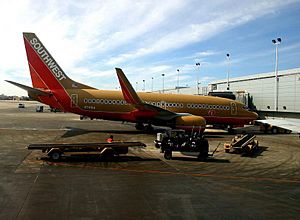
On March 16, 1995, Southwest launched its first website, Iflyswa.com. Passengers could see schedules and route maps. Southwest.com became a very successful airline website. By 2006, 70% of flight bookings and 73% of revenue came from the website.
Southwest became known for its smart business decisions, like using "fuel hedging" to protect itself from changing fuel prices. This helped them save money when fuel prices went up.
In March 1996, Southwest began building a 300,000 square feet (28,000 m2) addition to its headquarters, costing $30 million. They also leased land to build a new pilot training facility. By the end of 1997, these expansions and terminal improvements at Love Field were expected to cost Southwest $47 million.
In 1997, Southwest and Icelandair started a partnership. They offered joint fares and coordinated schedules, allowing passengers to transfer luggage and connect between U.S. cities and European cities through Baltimore.
The 2000s
Ending the Wright Amendment
In 1996, a new airline called Legend Airlines wanted to start long-distance flights from Love Field using planes with 56 seats, the maximum allowed by the Wright Amendment. However, the USDOT ruled that the 56-seat limit applied to the plane's original design, not how many seats were actually installed. Legend then tried to change the law.
By July 1997, Legend got help from Senator Richard Shelby. In October 1997, a new law called the Shelby Amendment was passed. It allowed unlimited flights to Alabama, Kansas, and Mississippi and allowed larger planes with 56 seats to fly nationwide. Southwest didn't add flights to these new states, saying there wasn't enough demand. However, other airlines started flying from Love Field.
On April 5, 2000, Legend Airlines began the first 56-seat long-haul flights from Love Field to places beyond the Wright and Shelby Amendment regions. Other airlines like American Airlines and Continental Express soon joined them. Southwest, which didn't use 56-seat planes, couldn't offer competing service.
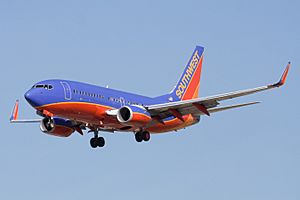
In late 2004, Southwest actively pushed for the Wright Amendment to be completely removed. In late 2005, Missouri was added to the list of allowed destination states. New service from Love Field to Saint Louis and Kansas City quickly started in December 2005.
In June 2006, Southwest made an agreement with Dallas, Fort Worth, DFW Airport, and American Airlines to support the repeal of the Wright Amendment. This agreement permanently limited the number of gates at Love Field to 20. It also said that Southwest would lose gates at Love Field if it offered flights from any airport within an 80-mile (130 km) radius (like DFW). These rules were set to expire on January 1, 2025.
Both the U.S. Senate and House of Representatives passed the new law on September 29, 2006. President George W. Bush signed it on October 13, 2006. The new law became active on October 16, 2006.
Southwest started selling tickets under the new law on October 19, 2006. The agreement immediately removed the ban on connecting tickets. It also allowed unlimited flights to domestic destinations eight years later. Because of this agreement, Southwest could fly nationwide. The law also set the maximum number of gates at Love Field. Southwest controlled most of the gates. The official end of the Wright Amendment was marked by Southwest Airlines Flight 1013 arriving from Denver at Love Field on October 13, 2014.
Southwest is still the main airline at Love Field. Its headquarters, hangars, and training centers are next to the airport. The airline's logo, a winged heart, and its stock symbol (LUV) show its connection to Love Field.
2000–2009 Events
On March 5, 2000, Southwest Airlines Flight 1455, a Boeing 737, went off the runway at Burbank-Glendale-Pasadena Airport in California. It skidded across a street and stopped at a gas station. Two passengers were seriously hurt, and the plane was badly damaged. This was the first major accident in the airline's history. The accident was blamed on pilot error, with the pilots landing too fast.
Southwest's partnership with Icelandair ended in January 2007.
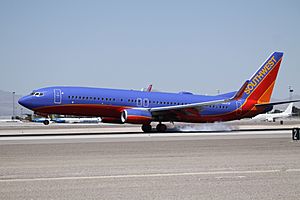
In 2008, Southwest started using a special water pressure-washing system to clean its engine turbine blades. This system helps improve fuel efficiency by about 1.9%.
Southwest paid $7.5 million to buy some assets from the bankrupt ATA Airlines in 2008. Southwest mainly wanted ATA's operating certificate and landing slots at New York's LaGuardia Airport.
On March 6, 2008, FAA inspectors told the U.S. Congress that Southwest had allowed 117 of its planes to fly with passengers even though they were "not airworthy." Some planes flew for up to 30 months after inspections were due. Records showed that thousands of passengers flew on planes considered unsafe. Southwest faced a $10.2 million fine. On March 12, 2008, Southwest voluntarily grounded 44 planes for checks. On March 2, 2009, Southwest settled these claims, agreeing to pay the FAA $7.5 million for safety and maintenance issues.
On July 8, 2008, Southwest Airlines signed a partnership agreement with WestJet of Canada. This would allow the two airlines to sell seats on each other's flights. However, this partnership was later canceled on April 16, 2010, due to economic conditions.
On July 30, 2009, Southwest Airlines tried to buy bankrupt Frontier Airlines Holdings. Southwest planned to operate Frontier separately at first, then combine it with Southwest. However, Southwest lost the bid to another company.
Southwest signed its second international partnership agreement on November 10, 2008, with the Mexican airline Volaris. This allowed Southwest to sell tickets on Volaris flights.
On August 26, 2009, the FAA investigated Southwest for installing incorrect parts on about 10% of its jets. The work was done by an outside company. The FAA said the parts didn't pose a safety danger, and Southwest was given until December 24, 2009, to replace them.
The 2010s
Buying AirTran Airways
Southwest Airlines announced it would buy AirTran Airways on September 27, 2010. They received final approval on April 27, 2011. On May 2, 2011, Southwest completed the purchase of AirTran Airways. Southwest estimated the deal was worth $3.2 billion. This purchase gave Southwest access to Atlanta, international service, and more landing slots at New York-LaGuardia Airport and Washington-Reagan Airport. Southwest fully combined with AirTran by December 28, 2014.
Southwest slowly moved AirTran's planes, routes, and employees into Southwest's operations.
The purchase added 25 new destinations for Southwest, including cities in the Caribbean and Boston, Massachusetts. On October 10, 2011, USA Today reported that Southwest would change how AirTran scheduled flights in Atlanta.
On February 14, 2013, Southwest began sharing flights with AirTran. They started with five markets and expanded to all cities (domestic and international) by April 2013. The airlines were fully combined on December 29, 2014.
2010–2019 Events
For ten years in a row, Fortune magazine recognized Southwest Airlines in its survey of corporate reputations. In 2004, Fortune listed Southwest Airlines as number three among America's Top Ten most admired companies.
On December 13, 2011, Southwest ordered 150 Boeing 737 MAX aircraft, becoming the first customer for this type of plane. The first 737 MAX was delivered to Southwest on August 29, 2017, and its first flight with passengers was on October 1.
In January 2012, Southwest Airlines showed interest in flying to Mexican and South American destinations from Houston's William P. Hobby Airport. On May 30, 2012, Houston's city council approved Southwest's request. Southwest agreed to invest at least $100 million to upgrade Hobby Airport for international flights. Construction took two years, and international flights began in October 2015.
On April 11, 2012, Southwest added the 737-800 to its fleet. It seats 175 passengers, more than the 143-seater 737-700. The first 737-800 was named "Warrior One."
On February 22, 2013, the partnership agreement with Volaris ended. Most experts believed this was because Southwest's subsidiary, AirTran Airways, was expanding into more Mexican markets.
In September 2014, Southwest introduced new branding, including a new look for its planes and a new logo.
On October 13, 2014, the Wright Amendment rules at Dallas Love Field were removed. Southwest then expanded service from Love Field to include cities outside the previous restrictions.
Throughout 2014, Southwest expanded service at Reagan-National in Washington D.C. and LaGuardia Airport in New York City.
On June 10, 2016, Southwest received approval to begin flights to Cuba. Southwest was one of six airlines chosen to start scheduled service to Cuba. Southwest launched service from Fort Lauderdale–Hollywood International Airport to Varadero, Cuba and Santa Clara, Cuba.
In July 2016, a technology problem caused hundreds of Southwest flights to be canceled, leaving many passengers and crew stranded.
On April 17, 2018, Southwest Airlines Flight 1380 had an engine failure on a flight from New York to Dallas. The engine exploded, and a piece broke a passenger window. One passenger was partially pulled out of the broken window and later died from her injuries. This was the first death due to an accident in Southwest's history.
On March 13, 2019, the FAA grounded all 737 MAX aircraft. This happened after two crashes of 737 MAX planes in other countries. The 737 MAX 8 made up about 5% of Southwest's planes at the time. Southwest offered to rebook travelers on other planes without extra fees. By October 2019, the airline expected the MAX 8 to remain grounded until at least February 8, 2020, causing many flights to be canceled.
The 2020s
2020-2022: Pandemic and MAX Crisis
In January 2020, the Wall Street Journal reported that the United States Department of Transportation was investigating Southwest. The investigation found that Southwest flew over 17 million passengers on planes with unconfirmed maintenance records over two years. It also said the FAA had allowed Southwest to fly planes with unresolved safety concerns.
In March 2020, the COVID-19 pandemic severely impacted Southwest. Air travel in the U.S. dropped by 92% compared to March 2019. Southwest canceled 1,500 daily flights, about 40% of its schedule. By April 7, it was clear that summer travel would also be affected, so the airline suspended nearly 50% of its flights through June 27. On April 14, Southwest received federal funding: $2.3 billion in grants and a $1 billion low-interest loan.
In April 2020, Southwest suspended fewer flights than other major airlines. By April 28, Southwest had parked 350 of its 742 planes. They also delayed many new Boeing 737 MAX deliveries and were losing at least $30 million every day.
In July 2020, about one-third of Southwest's employees were interested in early retirement or long-term leave. Over 16,800 employees signed up for these programs. On October 5, 2020, CEO Gary C. Kelly announced pay cuts for non-union employees and senior management starting in 2021 to avoid layoffs. He also said Southwest would talk to its pilot and flight attendant unions about similar cuts. However, the unions were against this. On November 6, 2020, Southwest sent notices to 42 employees, threatening layoffs for the first time in the company's history. On November 18, another 402 notices were sent to mechanics. However, a new law passed on December 27, 2020, provided $15 billion in airline aid. Southwest then canceled the layoff notices and pay cuts.
During the airline industry's struggles due to the pandemic, Southwest tried to compete with larger airlines. They expanded into major hub airports and increased flights to vacation spots in 2021. Southwest added service to Bush Airport in Houston (a United hub) and O'Hare Airport in Chicago (a hub for United and American Airlines). This was Southwest's first time serving Bush Airport since 2005 and O'Hare Airport ever. Southwest also started service at Miami International Airport, an American Airlines hub. They also announced service to three Colorado ski cities and several southern destinations, adding ten new destinations in 2021.
In October 2020, Southwest considered the Airbus A220 as an alternative to the MAX 7 to replace its 737-700s. However, in March 2021, Southwest ordered 100 MAX 7 jets instead.
In November 2020, the FAA officially ended the 737 MAX grounding. Southwest began preparing its 34 737 MAX planes for service and retraining its pilots. On March 11, 2021, Southwest resumed 737 MAX operations.
Southwest reported a $3.1 billion loss for 2020. This was the first time the airline had not made an annual profit since 1972.
After the pandemic, Southwest changed its strategy. It started serving larger airports like O'Hare International Airport, Miami International Airport, and George Bush Intercontinental Airport, even though it already served smaller airports in those areas.
On June 23, 2021, Gary Kelly announced he would retire as CEO in February 2022. Bob Jordan took his place. Kelly said he would remain as executive chairman of the board until at least 2026.
2022 Flight Problems
On December 26, 2022, Southwest Airlines canceled about 70% of its scheduled flights due to a severe winter storm. Even after the weather improved, more flights were canceled in the following days. Many passengers couldn't reach the airline and were left stranded without their luggage. The United States Department of Transportation responded to these issues. On December 28, the airline canceled even more flights for an extended period because its operational systems were damaged.
2022–2024: Company Changes
In November 2023, Southwest Airlines and DFW Airport confirmed they were discussing Southwest starting service there after the rule requiring the airline to give up Love Field gates expires in 2025.
Southwest lost money in late 2023 and early 2024. In April 2024, they announced they would limit hiring and stop flying to Bellingham International Airport, Cozumel International Airport, George Bush Intercontinental Airport, and Syracuse Hancock International Airport. In May 2024, Southwest Airlines fares started appearing on Google for the first time. Two months later, Southwest announced it would end its open seating policy. The airline will begin assigning seats, introduce premium seating options, and launch overnight flights in 2026.
In June 2024, Elliott Investment Management, an investment fund, announced it had bought a large share of Southwest. They wanted to change the leadership, saying the company had "failed to evolve." The fund launched a website, StrongerSouthwest.com, to explain their ideas to shareholders. In September, it was revealed that Elliott owned over 10% of Southwest's stock. Elliott demanded that Gary Kelly and Bob Jordan be removed, blaming them for the recent drop in Southwest's stock value.
The day after a meeting with Elliott, Southwest announced on September 10 that six of its board members would resign on November 21. Gary Kelly also said he would not seek re-election as executive chairman in spring 2025. Bob Jordan was expected to remain as CEO.
In November 2024, five of Elliott's chosen nominees joined Southwest's board. This was the largest number of board seats Elliott had ever gained in a deal with a U.S. company. Kelly retired early. Southwest also promoted Rakesh Gangwal, who had joined the board in July 2024, to chairman of the board. Gangwal is a co-founder of India's largest airline, IndiGo.


